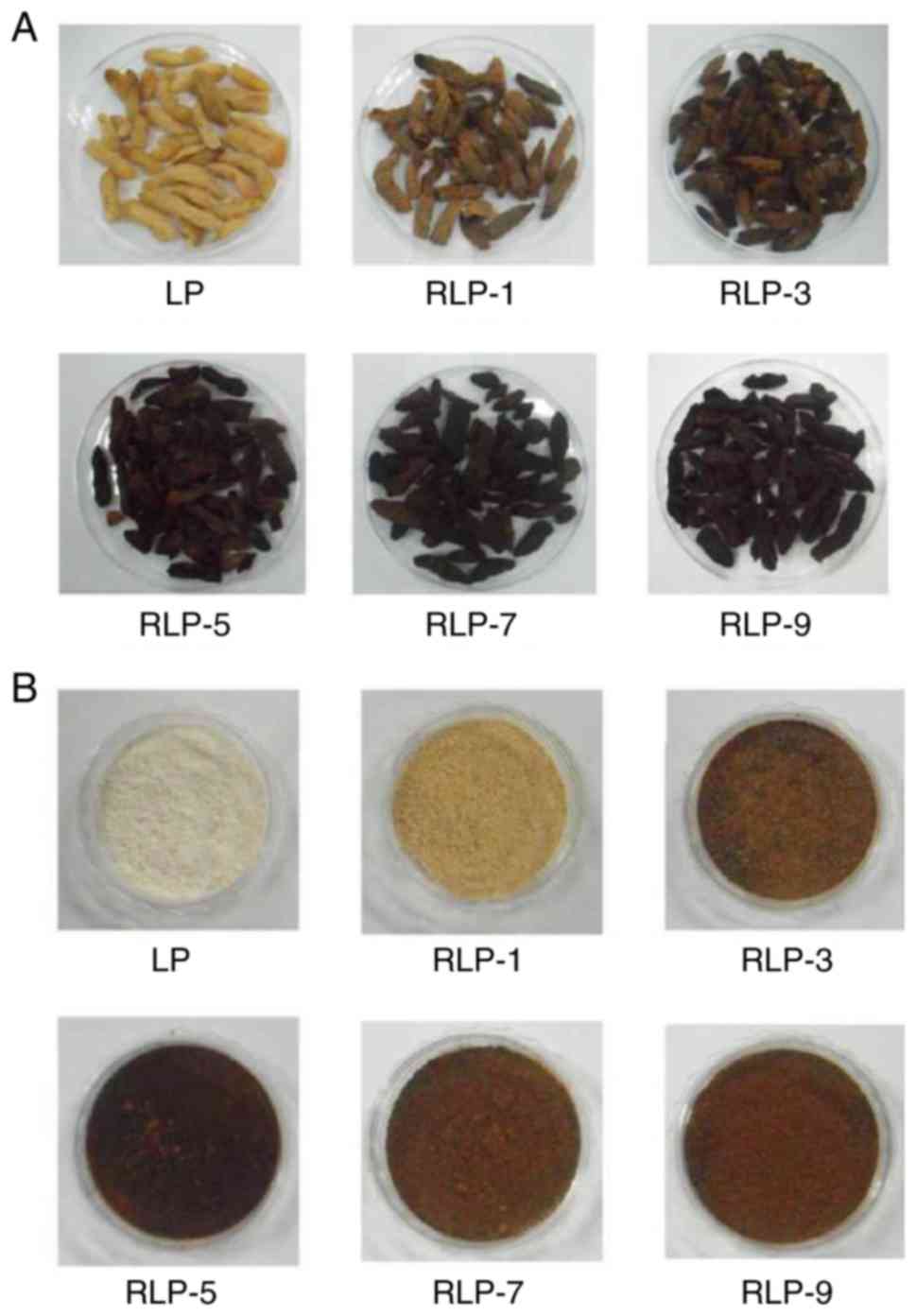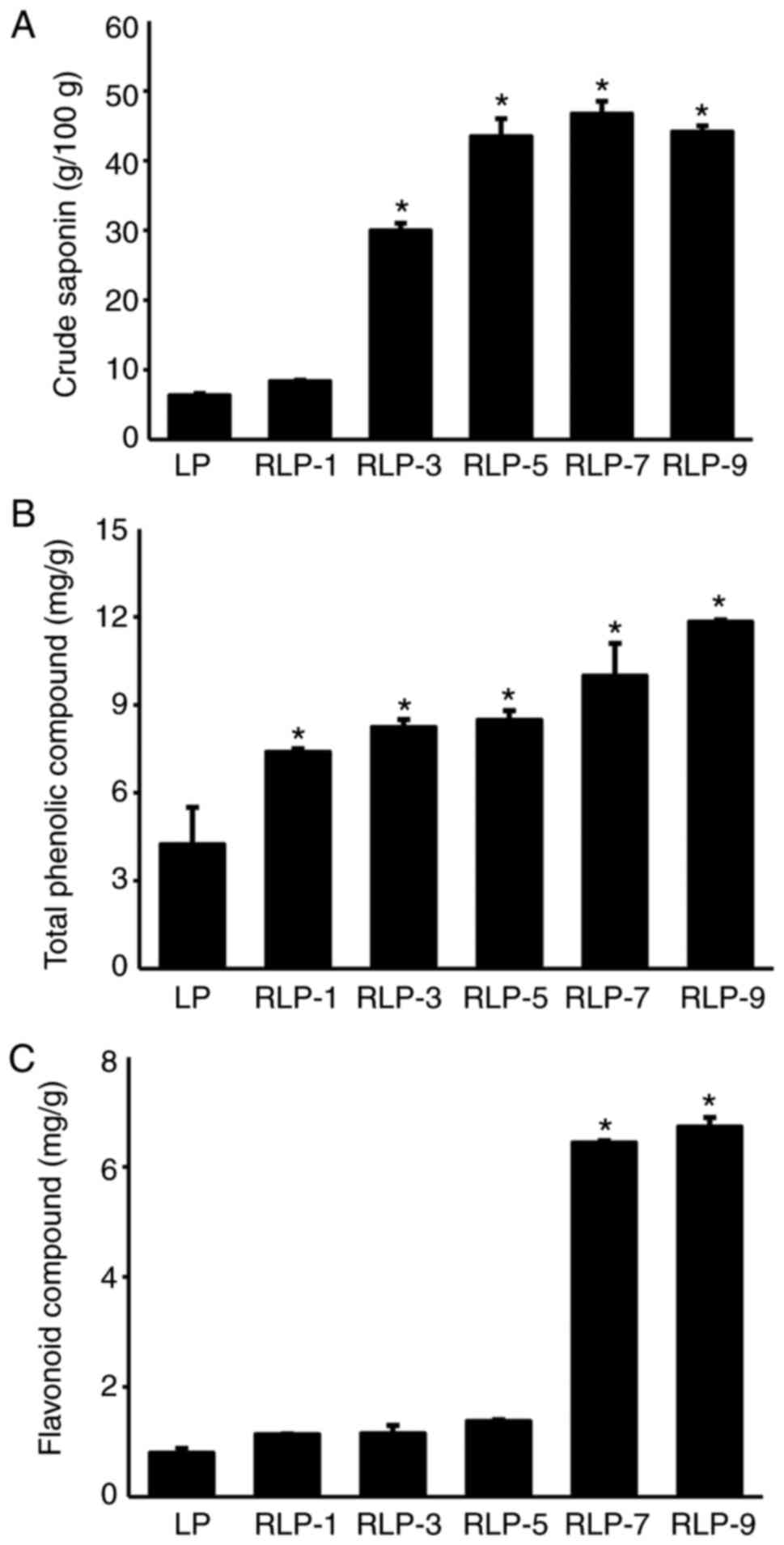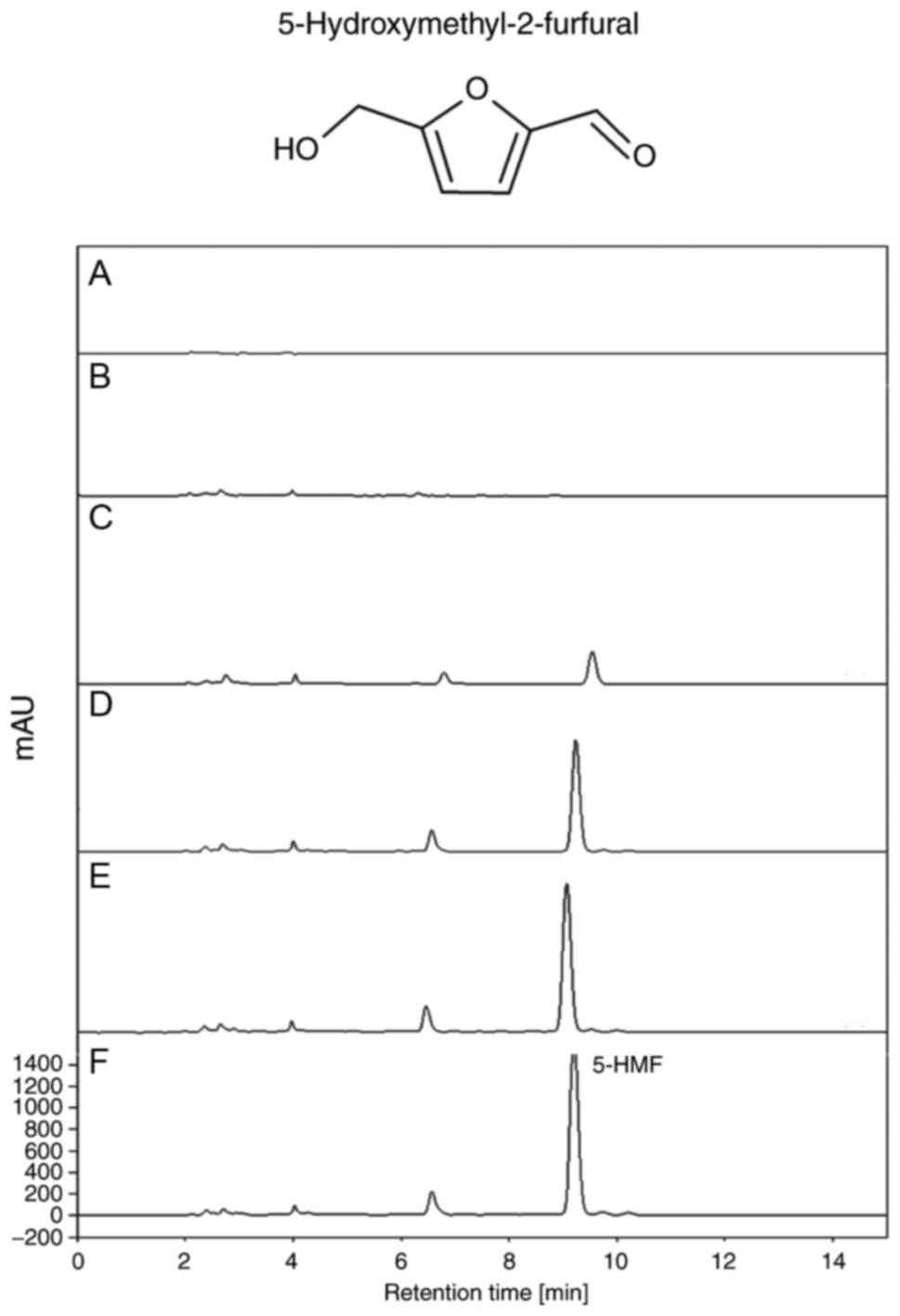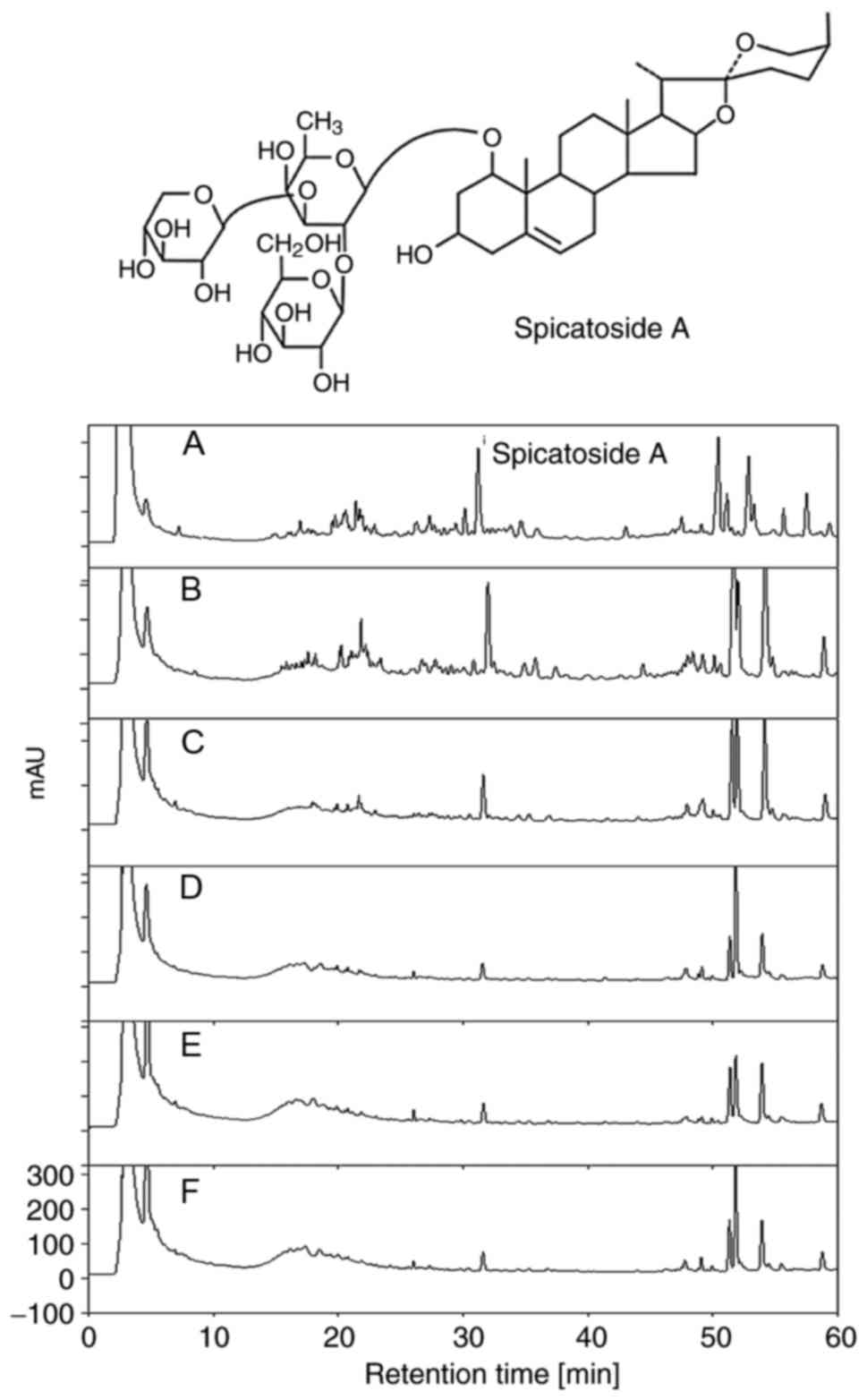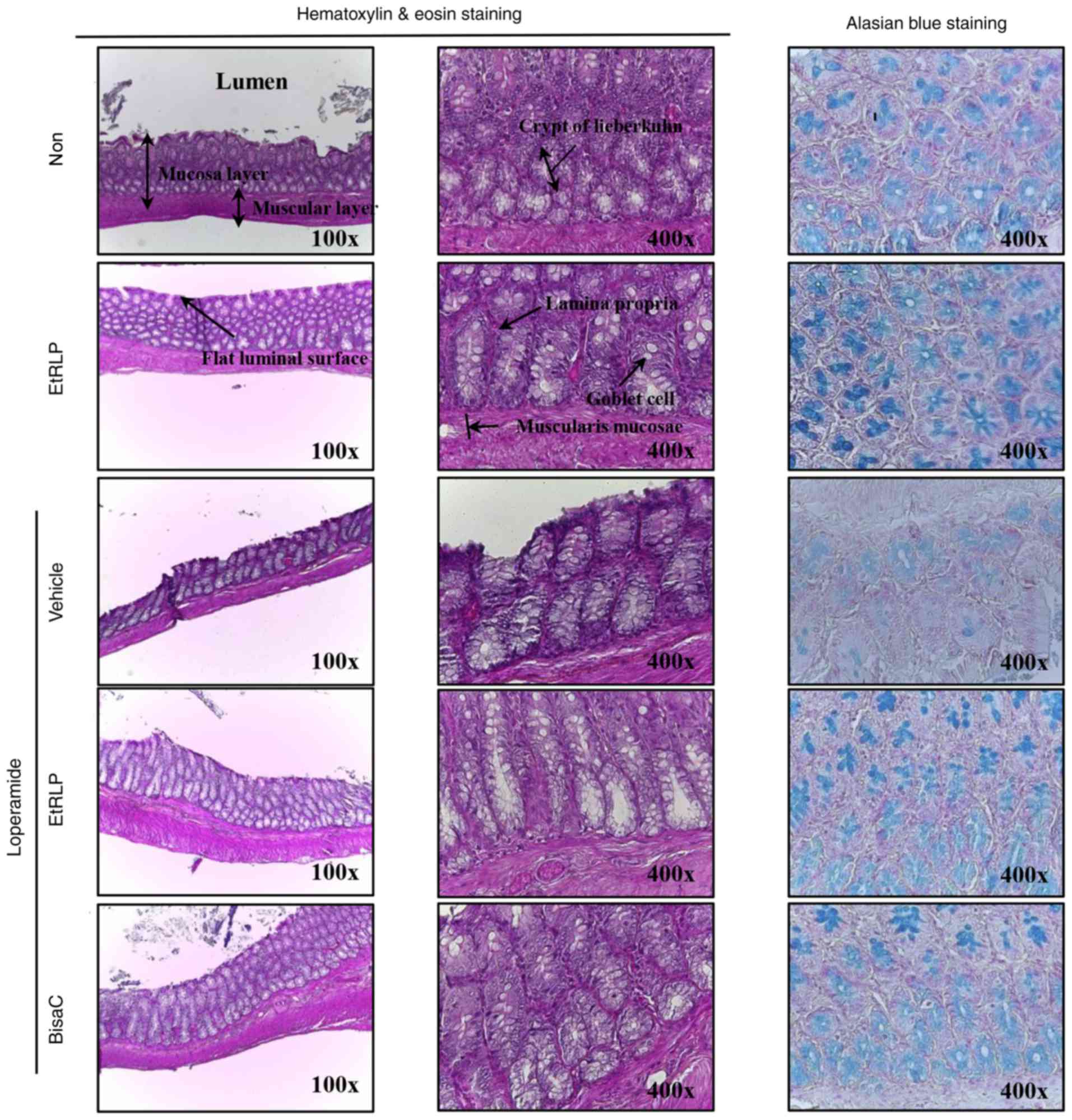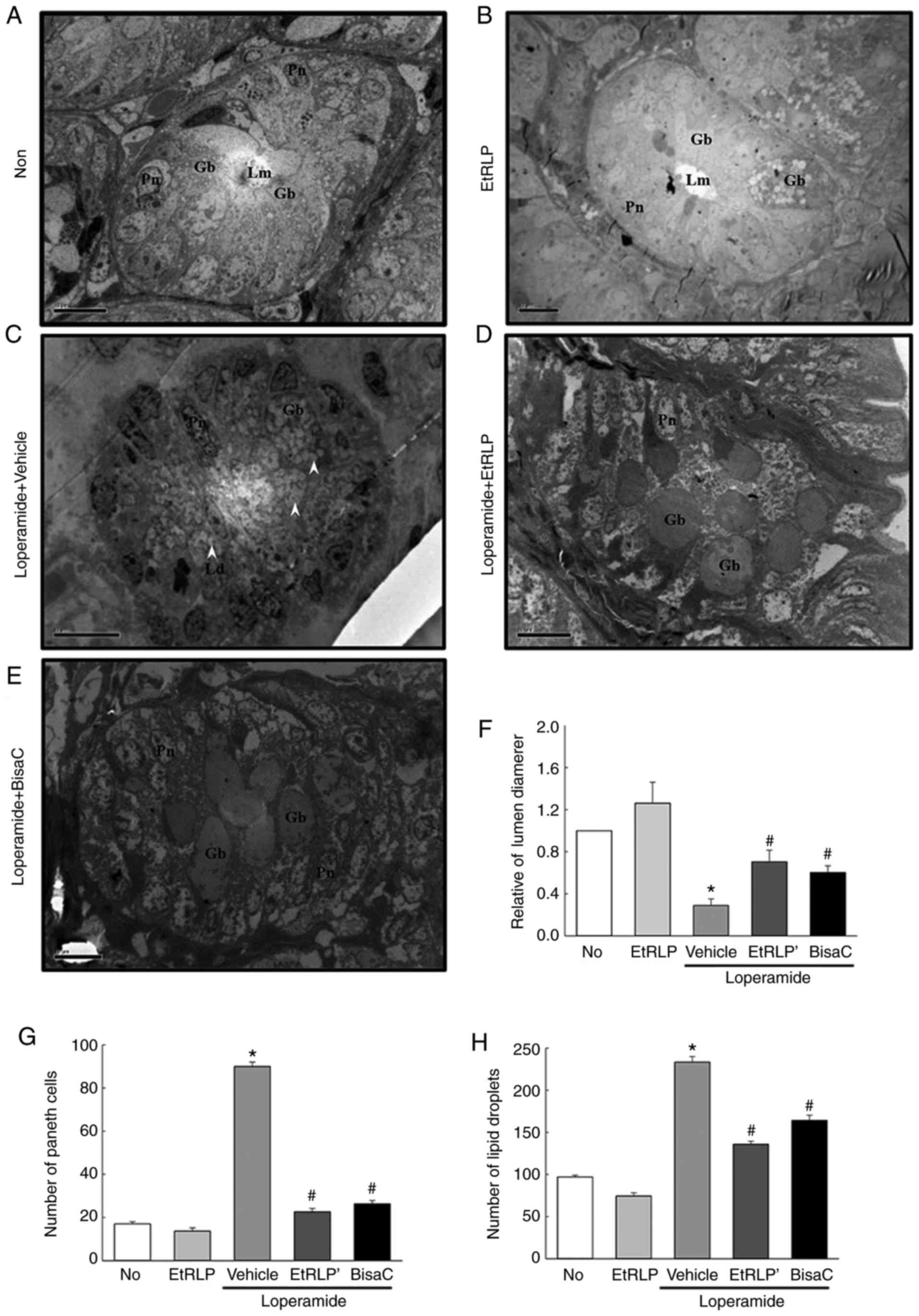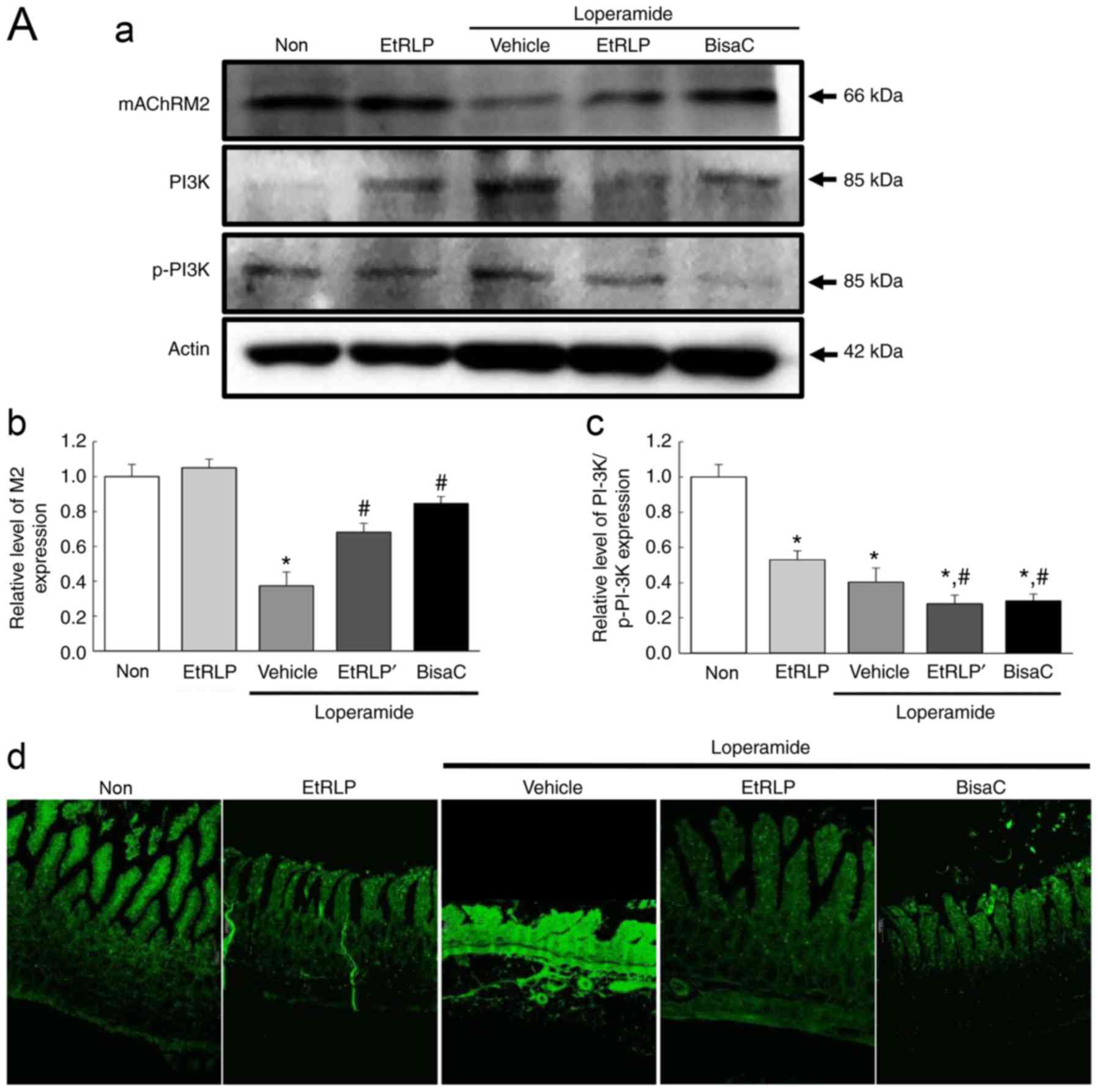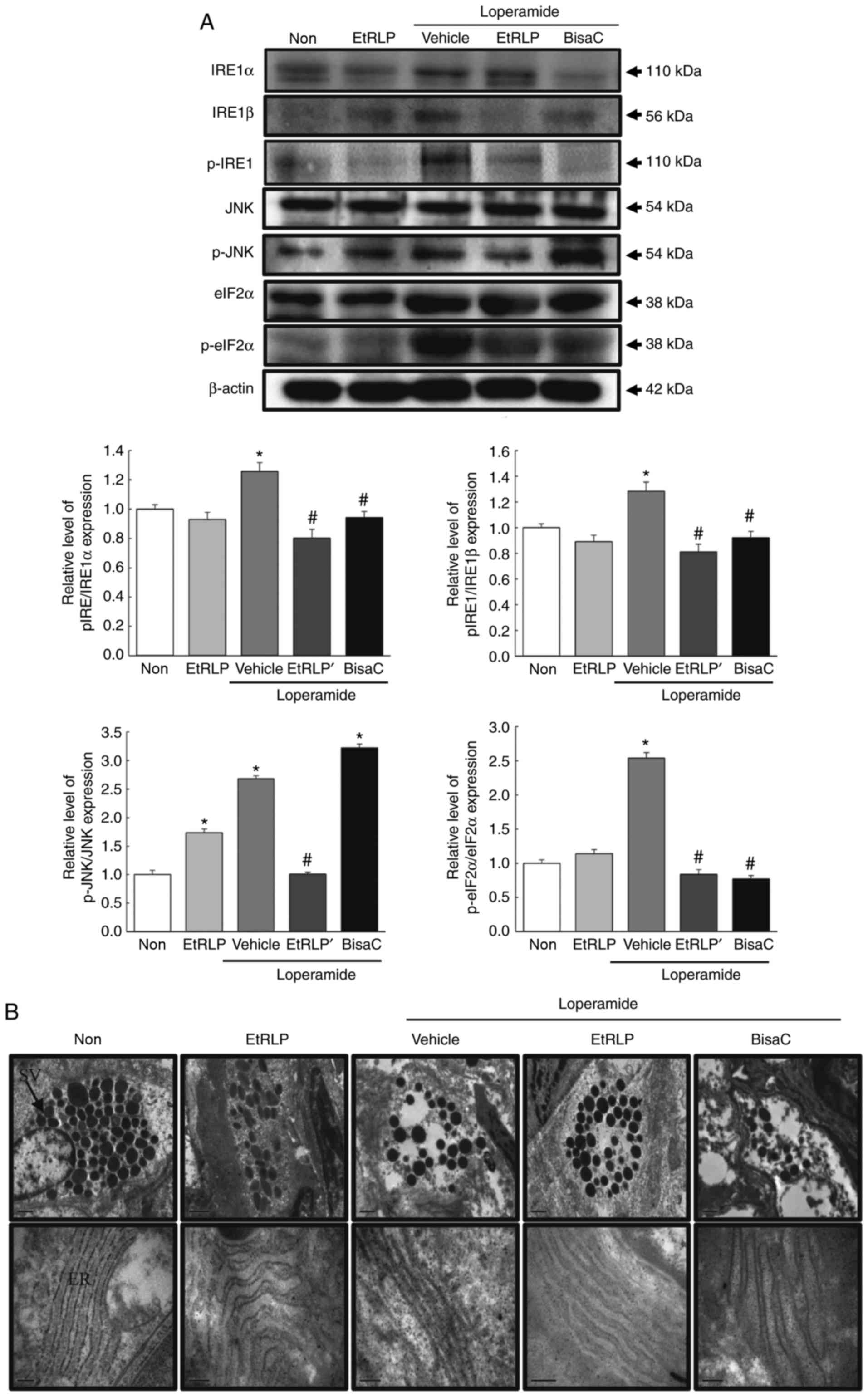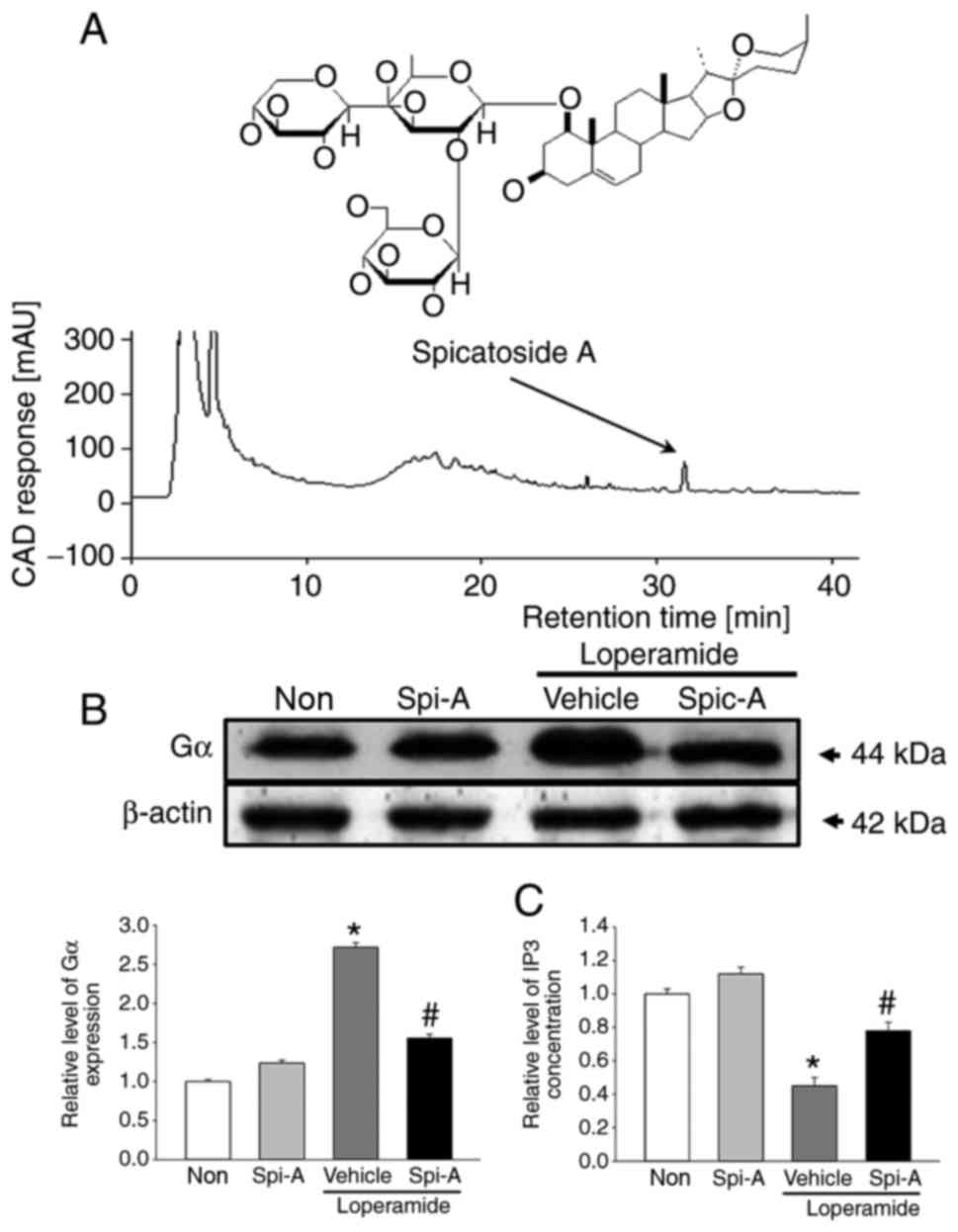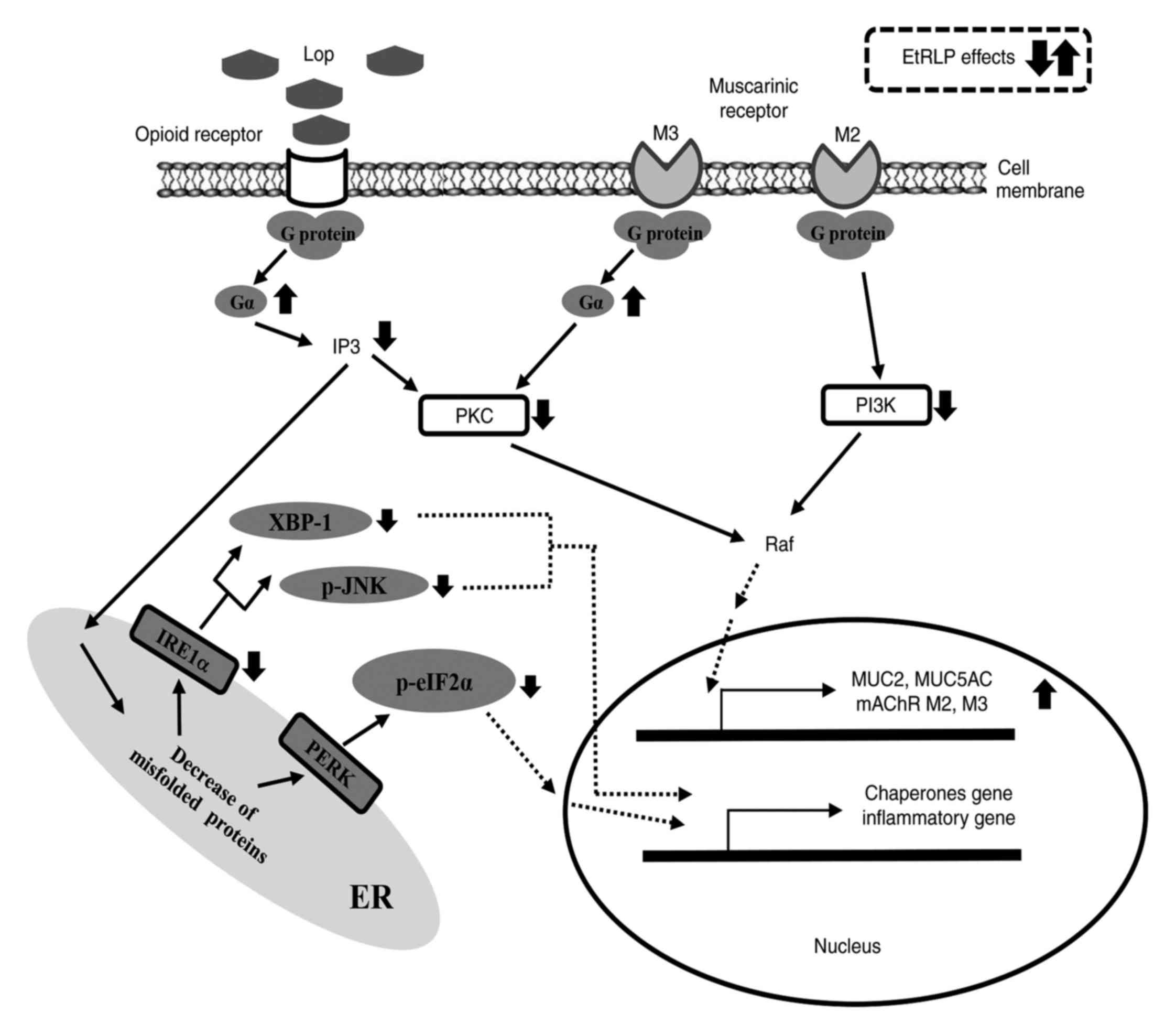Spicatoside A in red Liriope platyphylla displays a laxative effect in a constipation rat model via regulating mAChRs and ER stress signaling
- Authors:
- Published online on: October 29, 2018 https://doi.org/10.3892/ijmm.2018.3960
- Pages: 185-198
-
Copyright: © Kim et al. This is an open access article distributed under the terms of Creative Commons Attribution License.
Abstract
Introduction
Chronic constipation, a gastrointestinal disorder, presents symptoms such as hard stools, infrequent bowel movements, incomplete bowel evacuation, difficulty during defecation, and the need for excessive straining (1-3). Often, this disorder is the result of insufficient dietary fiber and fluid intakes, decreased physical activity, colorectal cancer obstruction, hypothyroidism, and administration of certain drugs (4). Medical treatments for chronic constipation include the provision of bulk laxatives, osmotic agents, stimulant laxatives, lubricating agents, and neuromuscular agents (5,6). Commonly used stimulant laxatives include senna, bisacodyl and docusate; however, their use may be limited due to high costs and undesirable side effects including hypernatremia, hypokalemia and protein-losing enteropathy (7). Stimulant laxatives enhance the motility and secretion of the intestine through regulation of electrolyte transport by the intestinal mucosa, which occurs when smooth muscle, epithelial or nerve cells receive stimulation from such substances (8). Bisacodyl, a diphenylmethane derivative, has long been utilized as a first-line stimulant laxative worldwide. Bisacodyl is a prokinetic with hydrogogue effects that directly enhances motility, thereby enhancing the water content and decreasing transit time of stool in the large bowel (9,10).
Several plant extracts exhibit laxative activities via their ability to enhance intestinal motility, ileum tension, and the frequency and weight of stools. Leaf extracts of Aloe ferox Mill., agarwood (Aquilaria sinensis, A. crasna) and common fig (Ficus carica) paste are reported to significantly increase total stool weight and intestinal motility, and to normalize body weight in constipation rats treated with loperamide (Lop) (11-13). In addition, an aqueous extract of Liriope platyphylla (AEtLP) roots has been demonstrated to increase the frequency and weight of stools, villus length, crypt layer thickness, muscle thickness, mucin secretion, and accumulation of lipid droplets in crypt enterocytes (14). In that previous study, marked reductions in the levels of key factors in the muscarinic acetylcholine receptor (mAChR) signaling pathway were observed in the Lop+AEtLP-treated Sprague Dawley (SD) rats (14). Based on these findings, the present study investigated whether red L. platyphylla extract (EtRLP) has beneficial effects on factors associated with laxative effects in experimental constipation SD rats. The EtRLP used in the present study was produced by performing nine repetitions of a two-step process (steaming of L. platyphylla roots at 99°C for 3 h and air-drying at 70°C for 24 h). EtRLP has been considered a candidate for use in the improvement of constipation because it has been demonstrated to be useful in the treatment of various chronic conditions, including diabetes, obesity, and neurodegenerative disease (1-4). Additionally, although EtRLP is composed of crude protein, carbohydrates, crude ash, crude fat, and moisture, it has been reported to contain high concentration of total phenolic compounds, total flavonoids, and 5-hydroxmethyl-2-furfural (15,16). However, there are no reports on whether EtRLP has a therapeutic effect on constipation or on its mechanism of action.
In the present study, the laxative effects and molecular mechanism of EtRLP were investigated in constipation SD rats treated with Lop. The results provide evidence that EtRLP may be as effective as a commercial product containing bisacodyl, sennoside calcium, and docusate sodium at alleviating constipation. Additionally, the present study is the first to suggest that EtRLP’s laxative effect may be correlated with control of the mAChR signaling pathway and the endoplasmic reticulum (ER) stress response. Finally, the role of spicatoside A, a key component in EtRLP, as a laxative compound was elucidated.
Materials and methods
Preparation and analysis of EtRLP
Fresh roots of L. platyphylla were kindly provided from the Miryang National Agricultural Cooperation Federation at Miryang, Korea, and then dried in a heating dryer (Ilshinbiobase, Seoul, Korea) at 60°C after washing them clean. Voucher specimens of L. platy- phylla roots (WPC-11-010) were deposited in the Functional Materials Bank of the Wellbeing RIS Center (FMB-WRIS Center) at Pusan National University. The root samples were confirmed to be L. platyphylla by Dr. Shin Woo Cha, Division of Herbal Crop Research, National Institute of Horticultural and Herbal Science (Eumseong, Korea).
EtRLP was prepared according to the method described previously (15). Briefly, a two-step process (steaming 200 g of dry root samples at 99°C for 3 h after air-drying at 70°C for 24 h) was repeated nine times to prepare Red L. platyphylla (RLP) (Fig. 1A). Voucher specimens of RLP sample (WPC-11-015) were deposited in the FMB-WRIS Center at Pusan National University. Subsequently, the roots of RLP were completely reduced to powder by using an electric blender (Fig. 1B). A mixture of 200 g RLP root powder and 200 ml of distilled water was purified for 2 h at 100°C by using circulating extractor (IKA Labortechnik, Staufen, Germany). The supernatant of RLP was then concentrated in a vertical tube of rotary evaporator (EYELA, Tokyo, Japan) to obtain dry pellets of EtRLP, which were kept at −80°C until needed.
The composition and concentration of active compounds in the obtained EtRLP were analyzed by using methods described previously (15). The EtRLP was mainly comprised of large carbohydrates (83.22%) and small moisture (8.24%) with lesser amounts of proteins, fat, and ash. The total phenol and total flavonoid concentrations increased with an increasing number of steaming/drying episodes, but the level of crude saponins was saturated after five repetitions (Fig. 2). High-performance liquid chromatography (HPLC) results revealed that the levels of 5-hydroxymethyl-2-furfural were markedly increased with the increase in number of steaming/drying repetitions (Fig. 3); however, a reverse pattern was detected in the level of spicatoside A (Fig. 4).
Animal experiments
The experimental protocols involving the use of animals was rfeviewed and approved based on the ethical and scientific animal care procedures set by the Institutional Animal Care and Use Committee of Pusan National University (approval no. PNU-2012-0010). A total of 30 adult 8-week-old male SD rats (n=30) were purchased from Samtako BioKorea Com., (Osan, Korea) and handled in the Pusan National University, Laboratory Animal Resources Center, which is accredited by the Korea Food and Drug Administration (accredited unit no. 000231) and The Association for Assessment and Accreditation of Laboratory Animal Care International (accredited unit no. 001525). Rats were maintained in a pathogen-free state under a 12-h light/dark cycle (lights on between 06:00 h and 18:00 h) at a room temperature of 23±2°C and a relative humidity of 50±10%. Standard irradiated chow (Purina Mills, Seongnam, Korea) was provided ad libitum.
Constipation of SD rats was induced by subcutaneous injection of Lop (4 mg/kg body weight) in 0.9% NaCl twice a day for 3 days as described in previous studies (11), while the non-constipation rats received 0.9% NaCl alone. For the treatment experiments, 8-week-old SD rats (n=30) were divided into either non-constipation (n=14) or constipation (n=21) groups. The rats of non-constipation group were subdivided further into Non-treated (n=7) and EtRLP-treated (n=7) groups. The Non-treated group members were untreated throughout the experimental period, while the EtRLP-treated group members received a single treatment of 1,000 mg/kg body weight of EtRLP. SD rats of the Lop-induced constipation group were subdivided further into Lop+Vehicle-treated (n=7), Lop+EtRLP-treated (n=7), and Lop+BisaC-treated (n=7) groups. Following constipation induction, the Lop+Vehicle-treated group members received an equal amount of water via oral administration, whereas the other cotreatment group members received a single treatment of 1,000 mg/kg body weight of EtRLP or 3.3 mg/kg body weight of Bisacodyl (BisaC). Primarily comprised of BisaC, senno-side calcium, and docusate sodium, the BisaC was purchased from Kolon Pharmaceuticals (Gyenggido, Korea). At 24 h following EtRLP treatment, all SD rats were euthanized by using compressed carbon dioxide (CO2) gas. Tissue samples (transverse colon) were collected from animals and kept in Eppendorf tubes at −80°C until use.
Measurement of excretion parameters
SD rats were maintained in metabolic cages during the experimental procedure to avoid excretion sample cross-contamination. Total excreted stools and urine were collected at 10:00 am every day following Lop or EtRLP treatment. Stool weight and number were determined three times by using a chemical balance and a hand counter. Stool water content was defined as the weight of water in stools and calculated dry weight from wet weight as described in previous studies (11,14). Changes in urine volume were measured three times by using a volumetric cylinder.
Western blot analysis
Total tissue proteins were collected from the transverse colons of 5-6 rats from each of the five treatment groups (Non-, EtRLP-, Lop+Vehicle-, Lop+EtRLP- and Lop+BisaC-treated groups) and primary rat intestine smooth muscle cells (pRISMCs) using Pro-Prep Protein Extraction Solution (Intron Biotechnology Inc., Seongnam, Korea). The protein concentration of tissue lysates was calculated by bicin-choninic acid assay (cat. no. 23225; Thermo Fisher Scientific, Inc., Waltham, MA, USA) according to the manufacturer’s instructions. Following the separation of total proteins (30 μg) by 4-20% SDS-PAGE, these proteins were then transferred to nitrocellulose membranes for 2-3 h at 40 V. Subsequently, the membranes were incubated with primary antibodies targeting mAChR M2 (cat. no. AMR-002; 1:1,000; Alomone Labs, Jerusalem, Israel), mAChR M3 (1:1,000, cat. no. AMR-006; Alomone Labs), phosphoinositide 3-kinase (PI3K, 1:1,000, cat. no. 4292S; Cell Signaling Technology, Inc., Danvers, MA, USA), phosphorylated (p-) PI3K (1:1,000, cat. no. 4228S; Cell Signaling Technology, Inc.), protein kinase C (PKC, 1:1,000, cat. no. 2058S; Cell Signaling Technology, Inc.), p-PKC (1:1,000, cat. no. 9376S; Cell Signaling Technology, Inc.), inositol-requiring enzyme (IRE) 1α (1:1,000, cat. no. ab37073; Abcam, Cambridge, UK), IRE1β (1:1,000, cat. no. SC-10511; Santa Cruz Biotechnology, Inc., Dallas, TX, USA), p-IRE1 (1:1,000, cat. no. 48187; Abcam), c-Jun N-terminal kinase (JNK, 1:1,000, cat. no. 9252; Cell Signaling Technology, Inc.), p-JNK (1:1,000, cat. no. 9251; Cell Signaling Technology, Inc.), guanine nucleotide binding protein (G) α (1:1,000, cat. no. ab128900; Abcam), eukaryotic initiation factor (eIF) 2α (1:1,000, cat. no. 9722; Cell Signaling Technology, Inc.), p-eIF2α (1:1,000, cat. no. 9721; Cell Signaling Technology, Inc.) or β-actin (1:3,000, cat. no. A5316; Sigma-Aldrich Co.; Merck KGaA, Darmstadt, Germany) overnight at 4°C. The membranes were then treated with washing buffer solution (137 mM NaCl, 10 mM Na2HPO4, 2 mM KH2PO4, 2.7 mM KCl, and 0.05% Tween 20) and incubated with horseradish peroxidase-conjugated goat anti-rabbit immunoglobulin (Ig) G antibody (1:1,000, cat. no. G21234; Invitrogen; Thermo Fisher Scientific, Inc.) at room temperature for 2 h. Finally, proteins on the membrane blot were detected with the Chemiluminescence Reagent Plus kit (Pfizer Inc., Gladstone, NJ, USA) and results were analyzed using SoftMax Pro 5.2 (Molecular Devices, LLC, Sunnyvale, CA, USA).
Histological analysis
Briefly, transverse colon samples were collected from 5-6 SD rats from each of the five treatment groups and fixed with 10% formalin for 48 h. The fixed samples were then embedded in paraffin blocks, cut into 4 μm thick sections, and stained with hematoxylin and eosin (H&E) solution (Sigma-Aldrich Co.; Merck KGaA). Their morphological features, including villus length, crypt layer thickness, and muscle thickness were measured by using Leica Application Suite software (Leica Microsystems, GmbH, Wetzlar, Germany).
For detection of mAChR M2 and M3 via immunofluores-cence staining analysis, transverse colon tissues were fixed in 10% formalin for 48 h, embedded in paraffin blocks, and sliced into 4 μm thick sections. Sections (n=5) were then deparaf-finized with xylene, rehydrated with different concentrations of EtOH, and pretreated with blocking buffer containing 10% goat serum (cat. no. 94010; Vector Laboratories, Inc., Burlingame, CA, USA) in PBS solution for 30 min at room temperature. The pretreated sections were then incubated with anti-mAChR M2 (1:200, cat. no. AMR-002; Alomone Labs) or anti-mAChR M3 (1:200, cat. no. AMR-006; Alomone Labs) antibodies diluted 1:1,000 in blocking buffer. After thorough washing in PBS solution, the sections were incubated with goat fluorescein isothiocyanate (FITC)-labeled anti-rabbit IgG (1:200, cat. no. A11008; Invitrogen; Thermo Fisher Scientific, Inc.) for 45 min, washed thrice in PBS for 30 min each, and mounted with vector shield mounting medium. Finally, green fluorescence intensity on the tissue section of transverse colon were detected using a Motic AE31 Inverted Phase Contrast Fluorescence Microscope (Motic Incoporation, Ltd., Causeway Bay, Hong Kong).
For mucin staining, transverse colon samples collected from 5-6 rats from each of the five treatment groups were fixed with 10% formalin solution for 48 h, embedded in paraffin blocks, and sectioned into slices with 4 μm thickness, which were subsequently deparaffinized with xylene and rehydrated with different concentrations of EtOH. The sections (n=5) were then washed with distilled water (dH2O) and stained with alcian blue staining solution (IHC WORLD, Woodstock, MD, USA). Finally, blue dots indicated mucin levels were observed in the stained colon tissue sections using light microscopy (Leica Microsystems, GmbH; DM500).
Transmission electron microscopy (TEM) analysis
Transverse colon tissues collected from 5-6 rats from each of the five treatment groups were fixed in 2.5% glutaraldehyde solution, rinsed with PBS solution, dehydrated with ascending concentrations of EtOH solution, postfixed in 1% osmium tetroxide (OsO4) for 1-2 h at room temperature, and embedded in Epon 812 media (Polysciences, Hirschberg an der Bergstrasse, Germany). Subsequently, ultra-thin sections of colon tissue (70 nm thick) were placed on holey formvar-carbon coated grids and then made the negative stain grids using uranyl acetate and lead citrate. Morphological features of tissues were examined by TEM (Hitachi, Ltd., Tokyo, Japan).
HPLC analysis
Spicatoside A in EtRLP was detected by using an Agilent 1100 HPLC system (Agilent Technologies, Inc., Santa Clara, CA, USA) comprised of an autosampler, a degasser, a diode array detector, an automatic thermostatic column compartment, and a quaternary pump. For spicatoside A analysis, a Shiseido CAPCELL PAK C18 MG column (Shiseido, Tokyo, Japan; 150x4.6 mm inside diameter, 5 mm particle size) was used with the following eluents: (A) 0.025% formic acid in water and (B) acetonitrile. A gradient programmer was used to apply the following HPLC program: 0-7 min (B: 8-12%, C: 10%), 7-23 min (B: 18-60% C: 10%), 23-35 min (B: 60%, C: 10%), 35-45 min (B: 60-90%, C: 10%), and 45-60 min (B: 90%, C: 10%). During analysis, the flow rate was 0.8 ml/min and the column temperature was 30°C. Flow rate and pressure were maintained at 1.53 l/min and 35±2 pound per square inch (psi), respectively. The output signals were detected at 254 nm and recorded with Clarity chromatography software (DataApex, Prague, Czech Republic).
Treatment of pRISMCs with spicatoside A
The pRISMCs used in the present study were prepared using a method described in previous studies, with slight modification (17). After the euthanasia of infant rats (3 days old) using a chamber filled with CO2 gas, their small intestines were collected from 1 cm below the pyloric ring to the cecum and excised along the mesenteric border. Gut luminal contents were removed from intestine by washing with calcium-free Hanks solution (5.36 mmol/l KCl, 125 mmol/l NaCl, 0.34 mmol/l NaOH, 0.44 mmol/l Na2HCO3, 10 mmol/l glucose, 2.9 mmol/l sucrose, and 11 mmol/l HEPES, pH 7.4). The opened intestine was pinned to the base plate of a silicon-covered Petri dish, and the mucosa layer was removed by sharp dissection. Small tissue strips of the circular and longitudinal muscles (~3-5 cm) were incubated in digestion mixture solution [1 mg/ml collagenase (Worthington Biochemical, Lakewood, NJ, USA), 0.5 mg/ml trypsin inhibitor (Sigma-Aldrich Co.; Merck KGaA), and 1 mg/ml bovine serum albumin (Sigma-Aldrich Co.; Merck KGaA)] at 37°C for 30 min. Digested tissue was centrifuged at 94 x g for 10 min and the pellet containing pRISMCs was harvested. The isolated cells were cultured in Dulbecco’s Modified Eagle’s Medium (DMEM; Hyclone; GE Healthcare Life Sciences, Logan, UT, USA) with 10% fetal bovine serum (FBS; Welgene, Daegu, Korea), then incubated in a culture incubator under a humidified atmosphere with 5% CO2 and 95% air.
The spicatoside A, used as a key compound, was kindly provided by the National Development Institute of Korean Medicine (Daegu, Korea). To investigate the effects of spicatoside A, pRISMCs were seeded into culture dishes (100 mm diameter) at a density of 107 cells in 10 ml, then incubated with 20 μM Lop for 12 h at 37°C. Subsequently, the culture media containing Lop were removed and the cells were incubated with 10 μM spicatoside A or PBS for a further 12 h, then collected by centrifugation at 848 x g for 10 min. The harvested pRISMCs were used to determine inositol triphos-phate (IP3) concentration and to measure the expression levels of specific proteins.
Determination of IP3 concentration
IP3 levels in pRISMCs were measured by ELISA (Cusabio Biotech, Wuhan, China; CSB-E13004r), based on the manufacturer’s manual. The pRISMCs (2x107) harvested from each of the five treatment groups were homogenized in ice-cold PBS (pH 7.2-7.4) by using a homogenizer (Sigma-Aldrich Co.; Merck KGaA). The supernatant from total cell lysate after centrifugation at 5,000 x g for 5 min at 4°C was then collected for IP3 analysis. A specific antibody for IP3 was added to the supernatant and the mixture was incubated at 37°C for 1 h, followed by the addition of substrate solution at 37°C for 15 min. The reaction was terminated by the addition of stop solution into the plate, and the optical density was measured at 450 nm with a VERSA max plate reader (Molecular Devices, LLC, Sunnyvale, CA, USA).
Statistical analysis
Statistical analyses were performed with SPSS for Windows, release 10.10, standard version (SPSS, Inc., Chicago, IL, USA). One-way analysis of variance followed by Tukey’s post hoc test for multiple comparisons was performed to identify significant differences between groups. Data were presented as mean ± standard deviation. P<0.05 was considered to indicate a statistically significant difference.
Results
Effects of EtRLP on feeding and excretion behavior of SD rats with Lop-induced-constipation
To investigate whether EtRLP treatment affects the feeding and excretion behavior of SD rats with Lop-induced constipation, the daily food intake, daily water consumption, and daily stool excretion were determined in each of the three treatment groups. No significant difference was observed in body weight and daily food intake between the Lop+Vehicle-treated and Lop+EtRLP-treated groups, while daily water consumption in the Lop+EtRLP-treated group was at a similar level to the Non-treated group (Table I). In addition, the decreased stool numbers and urine volumes were recovered in the Lop+EtRLP- and Lop+BisaC-treated groups to similar levels to the Non-treated group. Indeed, the water content and weight of stool in the Lop+EtRLP-treated group were significantly higher compared with the Non-treated group (Table I). These results suggest that EtRLP treatment can improve the excretion parameters of SD rats with Lop-induced constipation.
Recovery effect of EtRLP on histological alterations of the transverse colon
To investigate the beneficial effects of EtRLP treatment on the recovery of constipation-affected histological structures of the transverse colon, the villus length, thickness of crypt layer and muscle, and mucin secretion were measured in the rats with Lop-induced constipation. Transverse colon sampled from the Lop+Vehicle-treated group exhibited short length of the villus layer compared with the Non-treated group. Following Lop+EtRLP or Lop+BisaC treatments, the villus length increased by 110-120% relative to the Lop+Vehicle-treated group (Fig. 5 and Table II). Furthermore, the alterations in crypt layer and muscle thickness were similar to those in villus length, although crypt layer thickness only increased by 30-35% relative to the Non-treated group (Fig. 5 and Table II). The histological structure recovery was greater in the Lop+EtRLP-treated rats compared with the Lop+BisaC-treated rats. In addition, following Lop+EtRLP or Lop+BisaC treatments, the total mucin levels were markedly increased (by 90-110%) compared with the Non-treated group (Fig. 5). These findings indicated that EtRLP treatment improved the abnormal histological structure of the transverse colon in SD rats with Lop-induced constipation.
Improvement effect of EtRLP treatment on transverse colon ultrastructure
To determine if the recovering effect of EtRLP on transverse colon histological structure is accompanied by significant changes in its ultrastructure, organelles and cell microstructures were evaluated by TEM analysis. In the Non-treated group, crypts of Lieberkuhn formed a round structure, in which goblet cells, enterocytes and paneth cells surrounded a central lumen. In the EtRLP-treated group, the crypt structure was very similar to that in the Non-treated group, even though the EtRLP-treated group had an increased number of lipid droplets. Following Lop treatment, the ultra-structure of the crypt changed markedly in various parts of cell (Fig. 6). Specifically, there was a decreased diameter of the crypt lumen and an increased number of lipid droplets in the Lop+Vehicle-treated rats compared with the Non-treated rats. In the latter group, the affluence of lipid droplets and granules enhanced notably in enterocytes and paneth cells, while the levels in goblet cells were constant. However, in the Lop+EtRLP- and Lop+BisaC-treated groups, lipid droplets and granules were not distributed in enterocytes and paneth cells (Fig. 6). These results indicate that EtRLP treatment effectively restored Lop-altered transverse colon ultrastructure by enhancing the affluence of lipid droplets and granules in the crypts of Lieberkuhn in Lop-constipated rats.
Correlation between EtRLP treatment and the mAChR downstream signaling pathway
To determine if the laxative effects of EtRLP were accompanied by alterations in mAChRs signaling, the expression levels of mAChR-related proteins were detected in the three Lop-treated groups. The expression patterns of two mAChR proteins (M2 and M3) were similar among the experimental groups (Fig. 7). The lowest expression levels of those two receptors were observed in the Lop+Vehicle-treated group (Fig. 7). Following Lop+EtRLP or Lop+BisaC treatment, M2 and M3 levels were significantly increased, to levels similar to the Non-treated group (Fig. 7). The protein levels of mAChR M2 and M3 in the Lop+EtRLP-treated group increased by 184 and 286% respectively, relative to the Lop+Vehicle-treated group (Fig. 7).
However, the phosphorylation pattern of PI3K, a key signaling protein downstream of mAChR M2, was different from that of PKC, a key signaling protein downstream of mAChR M3, in all experimental. The phosphorylation level of PKC was recovered in Lop+EtRLP and Lop+BisaC-treated group, while that of PI3K was further decreased in the same groups (Fig. 7A-c and B-c). In addition, immunofluorescence assays revealed local distributions of M2 and M3 proteins in slide sections of the transverse colon. The observed fluorescence intensities for M2 and M3 supported the results obtained via western blot assays (Fig. 7A-d and B-d). Taken together, these results suggested that the laxative effects of EtRLP may be due to the downregulation of mAChR expression and its downstream signaling in the transverse colons of Lop-constipated SD rats.
Effects of EtRLP on the ER stress response
To investigate the beneficial effects of EtRLP treatment on the ER stress response in SD rats with Lop-induced constipation, alterations in ER stress biomarkers, including related protein levels and ultra-structure of the transverse colon, were examined by western blot and TEM analysis. The phosphorylation levels of IRE1α and IRE1β were increased in the Lop+Vehicle-treated SD rats compared with the Non-treated group. Following Lop+EtRLP or Lop+BisaC treatments, their levels almost recovered to the levels of the Non-treated group (Fig. 8A). Furthermore, the pattern of change in the phosphorylation levels of eIF2α was similar to the level changes in the phosphorylation of IRE1 in all treated groups. A similar phosphorylation pattern was also observed in JNK and IRE1 in the Non, Lop+Vehicle and Lop+EtRLP-treated groups. However, the level of JNK was not suppressed in Lop+BisaC-treated SD rats (Fig. 8A). Similar results were detected in the alteration patterns of ER stress protein levels detected by TEM analysis. We focused on alterations of paneth cells in the crypts of Lieberkuhn because they have been associated with ER stress, through PERK, eIF2α, and ATF4 (18). Compared to the secretory granule decrease in the Lop+Vehicle group, the number of secretory granules was enhanced in the Lop+EtRLP-treated group, while that in the Lop+BisaC-treated group remained at a similarly low level as that in the Lop+Vehicle group. In addition, the ER membrane sack was closely stacked in the cytoplasm of paneth cells in the Lop+Vehicle-treated group, while an intact ER sack was observed in the Non-treated group. Following Lop+EtRLP or Lop+BisaC treatment, the ER structure was recovered to be similar to the Non-treated group; however, the changes were not as clear in the Lop+EtRLP-treated group as in the Lop+BisaC group (Fig. 8B). These results indicate that the Lop-induced ER stress response in paneth cells may be improved by EtRLP treatment.
Identification of spicatoside A as a key component
Spicatoside A was selected as a potential compound for the treatment of constipation, because it is a main compound of EtRLP, it can stimulate epithelial cells, and it has been linked to neuronal cell function. Briefly, we confirmed the existence of spicatoside A in EtRLP by performing HPLC. As illustrated in Fig. 9A, spicatoside A was detected in the HPLC chromatogram of EtRLP after a retention time of 32 min. Then, the effects of spicatoside A as a laxative compound were investigated. To accomplish this, alterations in the mAChR downstream signaling pathway were measured in pRISMCs cotreated with Lop and spicatoside A. The expression levels of Gα protein were increased by 165% in the Lop+Vehicle-treated group compared with the Non-treated group (Fig. 9B). However, the levels in the Lop+spicatoside A-treated group were similar to those in the Non-treated or the spicatoside A-treated groups (Fig. 9B). Next, the IP3 concentrations were examined. The increased levels of IP3 concentration in the Lop+Vehicle-treated group were significantly lower following spicatoside A treatment (Fig. 9C). The present results indicated that spicatoside A can be considered as a laxative and a potential candidate to improve the symptoms of chronic constipation.
Discussion
Recently, many herbal plants and medicinal foods have received research attention as novel therapeutic strategies for use in the treatment of chronic constipation and its related conditions, because they may effectively improve a variety of conditions without significant adverse side effects (12,15,19). In an effort to assess the effects of plant-derived drugs for the treatment of constipation, the present study conducted an efficacy study of EtRLP produced from L. platyphylla root via a steaming process on an experimental model of Lop-induced constipation. The results clearly demonstrated that EtRLP treatment had a laxative effect, leading to increased stool and urine volumes, recovery of histological and cell ultrastructure changes in colon, and enhanced mucin secretion. Furthermore, the results are the first to demonstrate that the laxative function of EtRLP is closely associated with regulation of the mAChR signaling pathway and the ER stress response in the transverse colon of SD rats.
Extracts of L. platyphylla and RLP roots contain a great variety of functional components, but elucidation of the correlation between their properties and therapeutic effects requires further analyses. Carbohydrates (6.89 g/100 g) and sodium (6.32 g/100 g) are the predominant components of dried roots of L. platyphylla, with proteins, fats, and sugars also present but at much lower levels, while the level of trans-fat, saturated fat, and cholesterol are not detected (20). Previously, AEtLP was reported to contain saponins (1.73%), oligosaccharides (6.54%), succinic acid (111.48 mg/100 g), hydroxyproline (1,290 μg/100 g), and potassium (151.35 μg/100 g) (21). In addition, an ethanolic extract of L. platyphylla was examined, leading to the purification of five novel compounds, (-)-liriopein A/B, (+)platyphyllarin A/B, and ethyltributanoate, along with 21 previously reported secondary metabolites (22). However, very few reports have described the composition and bioactive compounds of EtRLP, a steam-processed extract of the L. platyphylla root. Previous reports have identified the total phenolic compounds, total flavonoid compounds, and the presence of diosgenin and 5-hydroxmethyl-2-furfural in EtRLP (15,16). However, further studies are needed to compare the concentrations of bioactive components between L. platyphylla and EtRLP to identify the key components with therapeutic effects against specific diseases. L. platyphylla, the raw material from which EtRLP was derived, has also been reported to effectively improve the symptoms of Lop-induced constipation (14). However, the rate of improvement in key factors was greater in the EtRLP-treated group compared with the L. platyphylla-treated group. In that previous study (14), stool weight, water content, and lumen diameter were higher in the EtRLP-treated group than in the L. platyphylla-treated group; however, the numbers of stools and paneth cells were similar in both groups. Furthermore, differences in the level of water consumption and food intake were detected in both groups, although body weights were similar. In the present study, water consumption was significantly lower in the Lop+EtRLP-treated group compared with the Lop+Vehicle group and the Lop+BisaC-treated group. In addition, food intake remained at a constant level in these groups even though their levels were lower than the Non-treated group. Such differences between studies can be attributed to differences in composition and concentration of several compounds contained in the treatment materials.
The function of gut epithelial cell is regulated by mAChRs, which serve a role in the digestion process of foods and in absorption of nutrients, electrolytes and water, through acetylcholine action (23). Although mAChRs are expressed on neuronal and non-neuronal cells in the gastrointestinal system, subtype-specific expressions have not been fully described in the different tissues of rat intestine. Indeed, only a few studies have investigated whether M1, M2, and M3 are expressed in the epithelial cells of the ileum, or examined M4 expression in colon nerve fibers (1,24,25). In the present study, mAChR M2 and M3 proteins were detected in the transverse colons of normal and Lop-constipated SD rats. Additionally, alterations in PKC and PI3K phosphorylation levels in the mAChR downstream signaling pathway were observed in the transverse colon, and Gα and IP3 were measured in pRISMCs isolated from the transverse colon (Figs. 7 and 9). Although the present results suggest the importance of the mAChR signaling pathway in constipation, further studies are required to understand the role of other factors in the regulation of this mechanism.
Protein misfolding within the ER can be enhanced by a variety of disturbances, including viral infection (26), abnormal calcium regulation (27), mutation (28), and high fat intake (29). An accumulation of unfolded proteins in the ER lumen leads to ER stress response. During ER stress, glucose-regulated protein 78 (GRP78) initiates an unfolded protein response (URP) signaling cascade (30). This signal is propagated via three ER-localized transmembrane proteins: double-stranded RNA-dependent protein kinase-like ER kinase (PERK), IRE1α and activating transcription factor 6 (ATF6) (31,32). The expression of biomarkers, such as GPR78, IRE1, ATF6, and PERK, is decreased in response to Wolfberry water-soluble phytochemicals in Jurkat cells (33). In the present study, the levels of IRE1 and JNK phosphorylation were significantly lower in the Lop+EtRLP-treated group. The present results are in agreement with previous reports (31,32), although the investigated models differed. The ER stress response is also observed in various diseases or abnormal conditions, including cancer, neurodegenerative disease, diabetes and ischemia (34-36). However, evidence of a correlation between the responses of ER stress and constipation, as well as between EtRLP’s laxative effects and ER stress, has not been presented to date. In the present study, the results from western blot and TEM analyses indicated that ER stress may be a key marker of clinical symptoms in SD rats with Lop-induced constipation. In addition, the results of the present study demonastrated that ER stress was lowered by EtRLP treatment. Therefore, it is worth studying the laxative effects of EtRLP in an experimental model with constipation in order to elucidate the mechanism associated with the response of ER stress.
In the present study, spicatoside A was selected as a candidate laxative treatment to improve chronic constipation. This compound was first isolated as a novel monoterpenoid from whole Mentha spicata L. and exhibits anti-inflammatory and hemostatic activities (37). Notably, it has also been isolated from L. platyphylla (38). Few studies have investigated the role of spicatoside A in biological processes to date. Spicatoside A induced neurite outgrowth via TrkA activation and enhanced memory consolidation via an increase in hippocampal mBDNF levels (38,39). This compound has also been described as a therapeutic drug that can inhibit cartilage breakdown in joints (40). Furthermore, spicatoside A has been reported to enhance mucin production and secretion by directly stimulating airway epithelial cells (39). Based on these results, spicatoside A was selected as a candidate compound that may have laxative activity. The present results suggested that spicatoside A can be considered a laxative.
Taken together, the results of the present study suggested that EtRLP recovered several key excretion parameters, including stool number, stool water content and urine quantity, in Lop-induced constipated SD rats. Furthermore, EtRLP treatment recovered villus length, thickness of crypt layer and muscle, and the secretion of lipid droplets in Lop-constipated SD rats. In addition, EtRLP treatment enhanced the expression of several genes, including mAChRs and mucins, through the regulation of PKC, PI3K and IP3 levels, while it may inhibit chaperons and inflammatory genes through the suppression of X-box binding protein 1 (XBP1), p-JNK and p-eIF2α activation (Fig. 10). The present findings provide evidence that the laxative effects of spicatoside A-containing EtRLP may be mediated by regulation of the mAChR signaling pathway and the ER stress response.
Acknowledgments
We thank the animal technician, Jin Hyang Hwang, for directing the care and management of animals at the Laboratory Animal Resources Center.
Funding
The present study was supported by the Basic Science Research Program through the National Research Foundation of Korea funded by the Ministry of Education (grant nos. 2014R1A1A2058360 and 2017R1D1A3B03032631).
Availability of data and materials
The analyzed datasets generated during the present study are available from the corresponding author on reasonable request.
Authors’ contributions
JEK, JG, HSL and DYH participated in the design of the study, sample preparation, animal experiments and data analyses. JTH helped with data analysis and manuscript preparation. All authors read and approved the final manuscript.
Ethics approval and consent to participate
All protocols involving animals were approved by the Pusan National University Institutional Animal Care and Use Committee (approval no. PNU-2012-0010).
Patient consent for publication
Not applicable.
Competing interests
The authors declare that they have no competing interests.
References
|
Walia R, Mahajan L and Steffen R: Recent advances in chronic constipation. Curr Opin Pediatr. 21:661–666. 2009. View Article : Google Scholar : PubMed/NCBI | |
|
McCallum IJ, Ong S and Mercer-Jones M: Chronic constipation in adults. BMJ. 338:b8312009. View Article : Google Scholar : PubMed/NCBI | |
|
Emmanuel AV, Tack J, Quigley EM and Talley NJ: Pharmacological management of constipation. Neurogastroenterol Motil. 21(Suppl 2): S41–S54. 2009. View Article : Google Scholar | |
|
Leung FW: Etiologic factors of chronic constipation: Review of the scientific evidence. Dig Dis Sci. 52:313–316. 2007. View Article : Google Scholar : PubMed/NCBI | |
|
Siegel JD and Di Palma JA: Medical treatment constipation. Clin Colon Rectal Surg. 18:76–80. 2005. View Article : Google Scholar : PubMed/NCBI | |
|
Portalatin M and Winstead N: Medical management of constipation. Clin Colon Rectal Surg. 25:12–19. 2012. View Article : Google Scholar : | |
|
Tzavella K, Riepl RL, Klauser AG, Voderholzer WA, Schindbeck NE and Müller-Lissner SA: Decreased substance P levels in rectal biopsies from patients with slow transit constipation. Eur J Gastroenterol Hepatol. 8:1207–1211. 1996. View Article : Google Scholar : PubMed/NCBI | |
|
Schiller LR: Review article: The therapy of constipation. Aliment Pharmacol Ther. 15:749–763. 2001. View Article : Google Scholar : PubMed/NCBI | |
|
Ewe K: Effect of bisacodyl on intestinal electrolyte and water net transport and transit. Perfusion studies in men. Digestion. 37:247–253. 1987. View Article : Google Scholar : PubMed/NCBI | |
|
Kienzle-horn S, Vix JM, Schuijt C, Peil H, Jordan CC and Kamm MA: Efficacy and safety of bisacodyl in the acute treatment of constipation: A double-blind, randomized, placebo-controlled study. Aliment Pharmacol Ther. 23:1479–1488. 2006. View Article : Google Scholar : PubMed/NCBI | |
|
Wintola OA, Sunmonu TO and Afolayan AJ: The effect of Aloe ferox Mill. in the treatment of loperamide-induced constipation in Wistar rats. BMC Gastroenterol. 10:952010. View Article : Google Scholar : PubMed/NCBI | |
|
Kakino M, Izuta H, Ito T, Tsuruma K, Araki Y, Shimazawa M, Oyama M, Iinuma M and Hara H: Agarwood induced laxative effects via acetylcholine receptors on loperamide-induced constipation in mice. Biosci Biotechnol Biochem. 74:1550–1555. 2010. View Article : Google Scholar : PubMed/NCBI | |
|
Lee HY, Kim JH, Jeung HW, Lee CU, Kim DS, Li B, Lee GH, Sung MS, Ha KC, Back HI, et al: Effects of Ficus carica paste on loperamide-induced constipation in rats. Food Chem Toxicol. 50:895–902. 2012. View Article : Google Scholar | |
|
Kim JE, Lee YJ, Kwak MH, Ko J, Hong JT and Hwang DY: Aqueous extracts of Liriope platyphylla induced significant laxative effects on loperamide-induced constipation of SD rats. BMC Complement Altern Med. 13:3332013. View Article : Google Scholar : PubMed/NCBI | |
|
Lee HR, Kim JE, Goo JS, Choi SI, Hwang IS, Lee YJ, Son HJ, Lee HS, Lee JS and Hwang DY: Red Liriope platyphylla contains a large amount of polyphenolic compounds which stimulate insulin secretion and suppress fatty liver formation through the regulation of fatty acid oxidation in OLETF rats. Int J Mol Med. 30:905–913. 2012. View Article : Google Scholar : PubMed/NCBI | |
|
Lee JS, Kim SH, Choi DW, Lee HS, Soon HJ and Hwang DY: Red Liriopis tuber production by steam and drying process of Liriopis tuber and development of its functional food products. Lee JS: Ministry of Agriculture, Food and +Rural Affairs; Sejong: pp. 285–289. 2013 | |
|
Kim JE, Koh EK, Song SH, Sung JE, Lee HA, Lee HG, Choi YW and Hwang D: Effects of five candidate laxatives derived from Liriope platyphylla on the 5-HT receptor signaling pathway in three cell types present in the transverse colon. Mol Med Rep. 15:431–441. 2017. View Article : Google Scholar | |
|
Adolph TE, Tomczak MF, Niederreiter L, Ko HJ, Böck J, Martinez-Naves E, Glickman JN, Tschurtschenthaler M, Hartwig J, Hosomi S, et al: Paneth cells as a site of origin for intestinal inflammation. Nature. 503:272–276. 2013. View Article : Google Scholar : PubMed/NCBI | |
|
Méité S, Bahi C, Yéo D, Datté JY, Djaman JA and N’guessan DJ: Laxative activities of Mareya micrantha (Benth.) Müll. Arg. (Euphorbiaceae) leaf aqueous extract in rats. BMC Complement Altern Med. 10:72010. View Article : Google Scholar | |
|
Shahbazian A, Heinemann A, Schmidhammer H, Beubler E, Holzer-Petsche U and Holzer P: Involvement of mu- and kappa-, but not delta-, opioid receptors in the peristaltic motor depression caused by endogenous and exogenous opioids in the guinea-pig intestine. Br J Pharmacol. 135:741–750. 2002. View Article : Google Scholar : PubMed/NCBI | |
|
Wingate D, Phillips SF, Lewis SJ, Malagelada JR, Speelman P, Steffen R and Tytgat GN: Guidelines for adults on self-medication for the treatment of acute diarrhoea. Aliment Pharmacol Ther. 15:773–782. 2001. View Article : Google Scholar : PubMed/NCBI | |
|
Huighebaert S, Awouters F and Tytgat GN: Racecadotril versus loperamide: Antidiarrheal research revisited. Dig Dis Sci. 48:239–250. 2003. View Article : Google Scholar : PubMed/NCBI | |
|
Hirota CL and McKay DM: Cholinergic regulation of epithelial ion transport in the mammalian intestine. Br J Pharmacol. 149:463–479. 2006. View Article : Google Scholar : PubMed/NCBI | |
|
Levey AI: Immunological localization of m1-m5 muscarinic acetylcholine receptors in peripheral tissues and brain. Life Sci. 52:441–448. 1993. View Article : Google Scholar : PubMed/NCBI | |
|
Anini Y, Hansotia T and Brubaker PL: Muscarinic receptors control postprandial release of glucagon-like peptide-1: In vivo and in vitro studies in rats. Endocrinology. 143:2420–2426. 2002. View Article : Google Scholar : PubMed/NCBI | |
|
Isler JA, Skalet AH and Alwine JC: Human cytomegalovirus infection activates and regulates the unfolded protein response. J Virol. 79:6890–6899. 2005. View Article : Google Scholar : PubMed/NCBI | |
|
Mattson MP: Calcium and neurodegeneration. Aging Cell. 6:337–350. 2007. View Article : Google Scholar : PubMed/NCBI | |
|
Chen YM, Zhou Y, Go G, Marmerstein JT, Kikkawa Y and Miner JH: Laminin β2 gene missense mutation produces endoplasmic reticulum stress in podocytes. J Am Soc Nephrol. 24:1223–1233. 2013. View Article : Google Scholar : PubMed/NCBI | |
|
Deldicque L, Cani PD, Philp A, Raymackers JM, Meakin PJ, Ashford ML, Delzenne NM, Francaux M and Baar K: The unfolded protein response is activated in skeletal muscle by high-fat feeding: Potential role in the down regulation of protein synthesis. Am J Physiol Endocrino Metab. 299:E695–E705. 2010. View Article : Google Scholar | |
|
Zhang K and Kaufman RJ: From endoplasmic-reticulum stress to the inflammatory response. Nature. 454:455–462. 2008. View Article : Google Scholar : PubMed/NCBI | |
|
Ron D and Walter P: Signal integration in the endoplasmic reticulum unfolded protein response. Nat Rev Mol Cell Biol. 8:519–529. 2007. View Article : Google Scholar : PubMed/NCBI | |
|
Schröder M and Kaufman RJ: The mammalian unfolded protein response. Annu Rev Biochem. 74:739–789. 2005. View Article : Google Scholar : PubMed/NCBI | |
|
Jiang Y, Zhang Y, Wark L, Ortiz E, Lim S, He H, Wang W, Medeiros D and Lin D: Wolfberry water soluble phytochemicals down-regulate ER stress biomarkers and modulate multiple signaling pathways leading to inhibition of proliferation and induction of apoptosis in jurkat cells. J Nutr Food Sci. S2:pii: 0012011. | |
|
Xu C, Bailly-Maitre B and Reed JC: Endoplasmic reticulum stress: Cell life and death decisions. J Clin Invest. 115:2656–2664. 2005. View Article : Google Scholar : PubMed/NCBI | |
|
Yoshida H: ER stress and diseases. FEBS J. 274:630–658. 2007. View Article : Google Scholar : PubMed/NCBI | |
|
Niederreiter L and Kaser A: Endoplasmic reticulum stress and inflammatory bowel disease. Acta Gastroenterol Belg. 74:330–333. 2011.PubMed/NCBI | |
|
Zheng J, Wu LJ, Zheng L, Wu B and Song AH: Two new mono-terpenoid glycosides from Mentha spicata L. J Asian Nat Prod Res. 5:69–73. 2003. View Article : Google Scholar : PubMed/NCBI | |
|
Hur J, Lee P, Moon E, Kang I, Kim SH, Oh MS and Kim SY: Neurite outgrowth induced by spicatoside A, a steroidal saponin, via the tyrosine kinase A receptor pathway. Eur J Pharmacol. 620:9–15. 2009. View Article : Google Scholar : PubMed/NCBI | |
|
Park SH, Lee HJ, Ryu J, Son KH, Kwon SY, Lee SK, Kim YS, Hong JH, Seok JH and Lee CJ: Effects of ophiopogonin D and spicatoside A derived from Liriope tuber on secretion and production of mucin from airway epithelial cells. Phytomedicine. 21:172–176. 2014. View Article : Google Scholar | |
|
Lim H, Min DS, Kang Y, Kim HW, Son KH and Kim HP: Inhibition of matrix metalloproteinase-13 expression in IL-1β-treated articular chondrocytes by a steroidal saponin, spicatoside A, and its cellular mechanisms of action. Arch Pharm Res. 38:1108–1116. 2015. View Article : Google Scholar : PubMed/NCBI |



